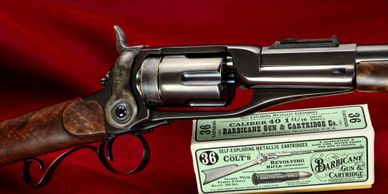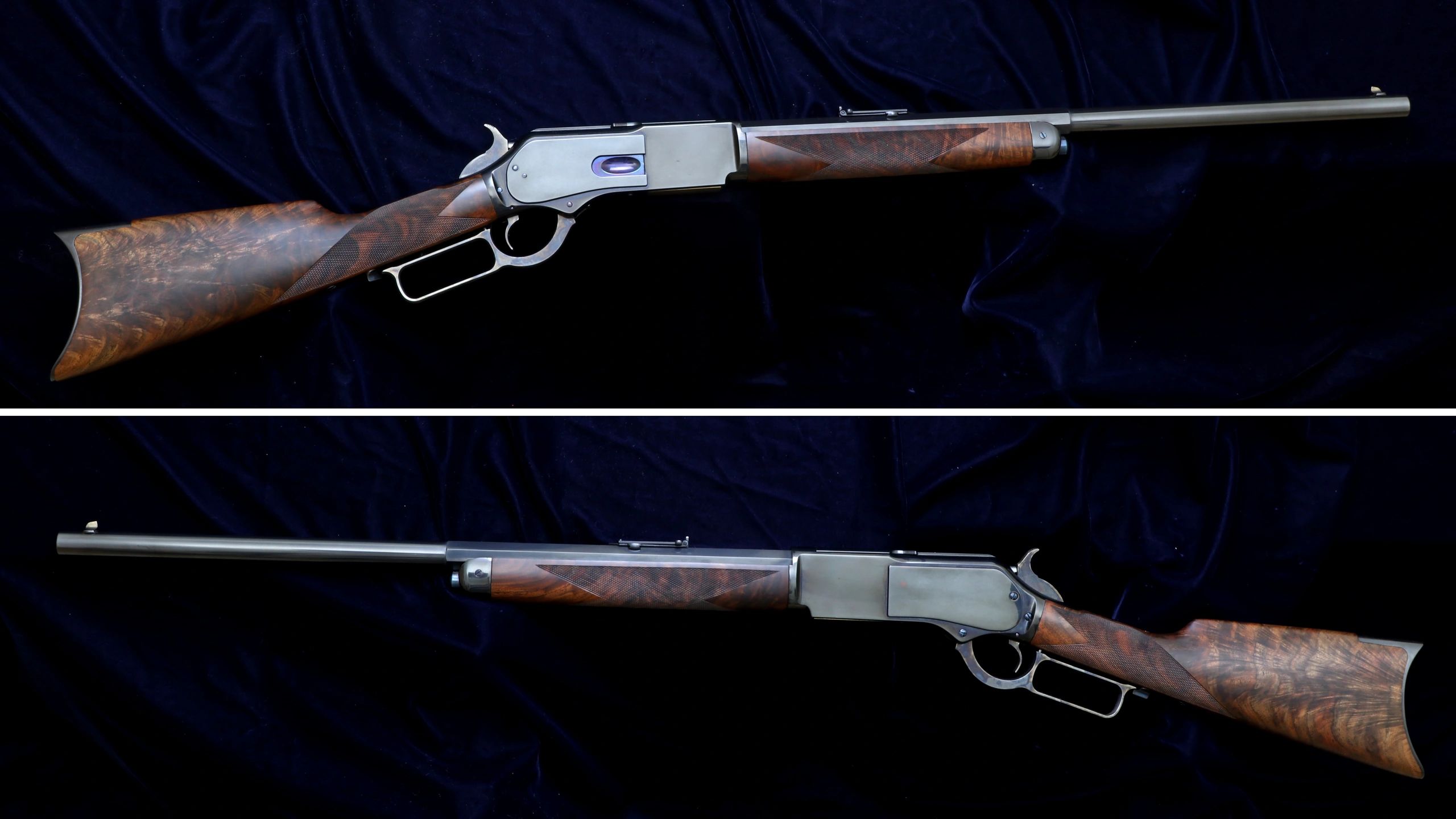The Historical Arms Galleries
WWII Galleries
Colours of the Queen's Rangers

Here are some of the photos from my two books The Matchless Enfield and FG42 currently available at Amazon.com (here).
Colours of the Queen's Rangers
Colours of the Queen's Rangers

The Colours of the Queen's Rangers are the oldest known military colors in North America (read about the colours here). Rifles, Rangers & Revolution about the Queen's Rangers, is the new book available at Amazon!
Colt Model of 1855

This Dixie/Palmetto Colt Model of 1855 Percussion Revolving Rifle has been turned into a custom Cartridge Conversion in .40-50 Sharps Bottleneck.
Old West Galleries
The Cold War and Colt Galleries

The Old West Galleries include reproduction and some original handguns and rifles for sport and target shooting. Scroll down for more!
The Cold War and Colt Galleries
The Cold War and Colt Galleries
The Cold War and Colt Galleries

The Cold War is featured here with FAL, AR-10 and a faux Dragunov built on a Russian Vepr. Below is the Colt Galleries featuring a variety of handguns and a reproduction Colt Bulldog Gatling Gun.
The Napoleonic Wars
The Cold War and Colt Galleries
The Cold War and Colt Galleries
The British Baker Rifle used by the 95th Rifles presaged the Scout/Snipers of WW II and were used in much the same fashion. Here find rifles and muskets as used by the French Voltiguers as well as the U.S. Marines aboard ship, too, as well as a gallery of Historex 54mm soldiers.
COLT MODEL OF 1855

I’ve always loved the lines of the Colt Model of 1855 and especially the percussion sporting rifle with its elegant fully fluted cylinder and fancy upscale features. Dixie imported a copy of the 6-shot .44 caliber Military Model of 1855 for a few years, but alas, build quality was such that staying with percussion would have meant trying to fit many new parts, including a hammer. So few guns were imported there were no spares at Dixie. Thus was born the Fantasy Custom Gun: How would Colt have done it? Secondarily, how would a competent custom shop do so? Such “bespoke” shops were open in England, and there were a few in America capable of such work. Historically, few tried, mind you, but there were conversions to rimfire of the big Colt, and seeing how much work Gemmer put into remodeling Spencers and Springfield Trapdoors, gave me confidence the idea wasn’t an impossible stretch. The elegant Colt Sporting models included many upscale features such as the wiping rod, keyed fore-end with pewter cap, fancy stocks, and a scroll triggerguard. This turned out to be a one of a kind build!

The action was never designed to take a cartridge, but readily accepts the breech ring and loading gate conversions. One reason the .40-50 SBN was chosen is it is one of the first cartridges offered to sportsmen, but that wasn’t the only reason. The various straight-wall cases we could have used all have been “magnumized” at some point, and as much fun as having this chambered for the black powder equivalent of the .500, .460 S&W or .445 Super Mag, use of one of those cartridges would likely prove catastrophic to the Italian framework. It simply wasn’t designed around black powder pressures.

Quite a pair! The Colt Richards Conversion is the perfect handgun to pair with the big rifle, and came in another of our first centerfire cartridges in the .44 Colt. The Richards Conversion is a Cimarron in .44 Special (don’t tell anyone it’s in a modern cartridge!).

A forward thinker back then would naturally improve the sighting over the earlier military model. Remington had invented a clever sight for their Rolling Block that consisted of a conventional open back sight that could be raised to provide a peep sight. Simple and handy. Montana Vintage Arms currently offers this one.
THE MATCHLESS ENFIELD No. 4 (T)
FG42
WORLD WAR II
Not deserted, just time out for a spot of tea.
Thanks for visiting the WW II Galleries
Below is the first of the new Revolutionary War galleries from the upcoming book Rifles, Rangers & Revolution about the Queen's Rangers and technology of 1776. The Colours of the Queen's Rangers are the oldest known in North America. (read about them in the Gazette here). Scroll down for the v
COLOURS OF THE QUEEN'S RANGERS
Detail of the King's Colours.
1876 Winchester

Cimarron's 1876 Winchester copy is a perfect platform for a custom gun. This one now has a 1/2 round, 1/2 octagon Douglas barrel in .50-95 of 24 inches with a 1/2 magazine holding 4 rounds (add one in the chamber for five rounds) and has been restocked in highly figured walnut. This configuration balances nicely for offhand shots.

The top group was fired at 100 yards with a 300-grain Barnes bullet over FFg black powder. The two bottom groups were fired at 50 yards. Fouling isn't a problem when jacketed bullets are used. The lower right hand group is five rounds at 50 yards. It's best to run a patch down the barrel every five rounds, but I've shot 10 without the group opening much. With cast bullets, a three-round group is max and accuracy falls goes to blazes for shots four and five.

John King correctly marked the Cimarron's dustcover with the markings Winchester used during the late 1800s.

The barrel has been given the correct original style of caliber markings.

Oddly enough, this is the correct barrel sight for these .50-95 Express Rifles. It is awfully optimistically graduated to 1,000 yards for the short, dumpy 300-grain bullet wheezing to get past 250 and dropping like a stone even so. At 100 yards, a 1/2-inch wide bullet is quite lethal, however. This sight is a reproduction from Buffalo Arms.

The front sight is a reproduction from Winchester Bob. The German silver blade is easy to see in the V-notch of the rear.
OLD WEST HANDGUNS
Cimarron 1872 .44 Colt and 1860 .44 Special as they come from the factory.
OLD WEST HUNTING & TARGET RIFLES
THE BALLARDS
Thanks for Visiting the OLD WEST Galleries!
Below is the Cold War and a sampling of Colt Revolvers and Pistols. The stills are from the movie House on Haunted Hill, co-starring the Colt 1903 .38 Auto Pocket Hammer! Below that is a reproduction of the Colt Bulldog Gatling Gun.
THE COLD WAR
COLTS
COLT GATLING

Nelson at Trafalgar
The Napoleonic War Galleries
Below are galleries for the Baker Rifle of the 95th Rifles, arms of the French Voltigeurs, The M1803 of the U.S. Marines and a few Historex 54mm soldiers for good measure. Enjoy!
The Pattern 1800 Baker Infantry Rifle
Eating Monsieur Crapaud's lunch.
NAPOLEONIC WARS
Nelson's death at Trafalgar 1805. Nelson was shot by a French musket, and avenged by Signals Midshipman Pollard with a musket.
TOY SOLDIERS NAPOLEONIC FRANCE
Some of the firearm photos are © FMG Publications, since they were taken by me to illustrate stories written for GUNS Magazine. Everything else is ©2025 by Jeff John. All rights reserved, whether my copyright or FMG's!
Powered by GoDaddy
